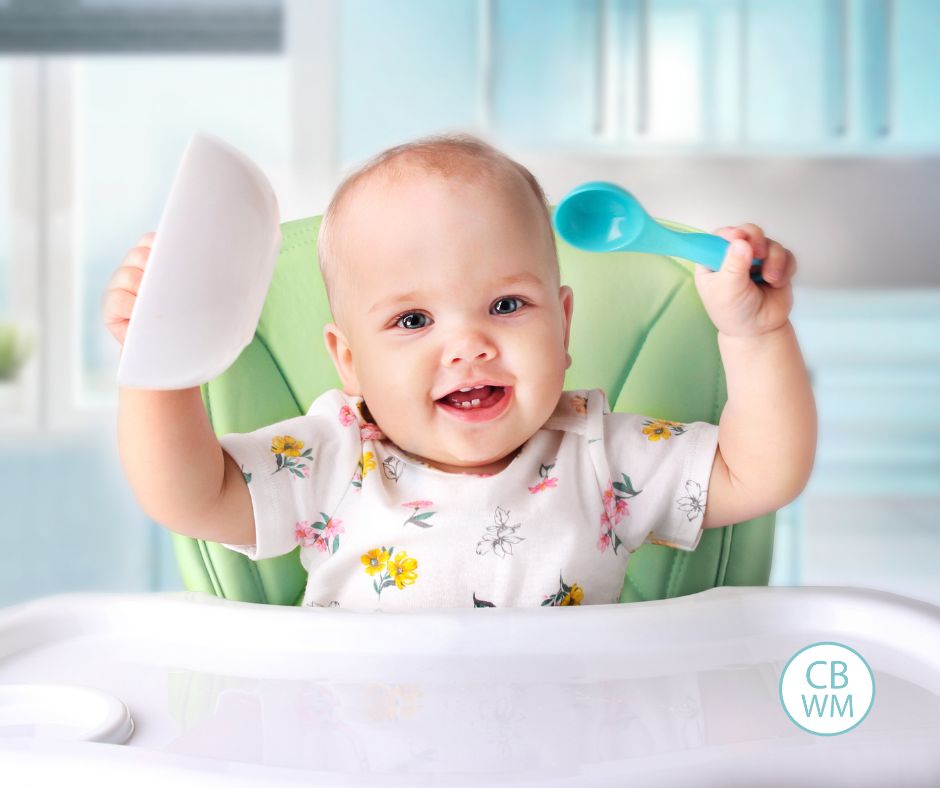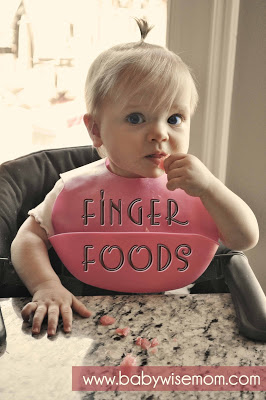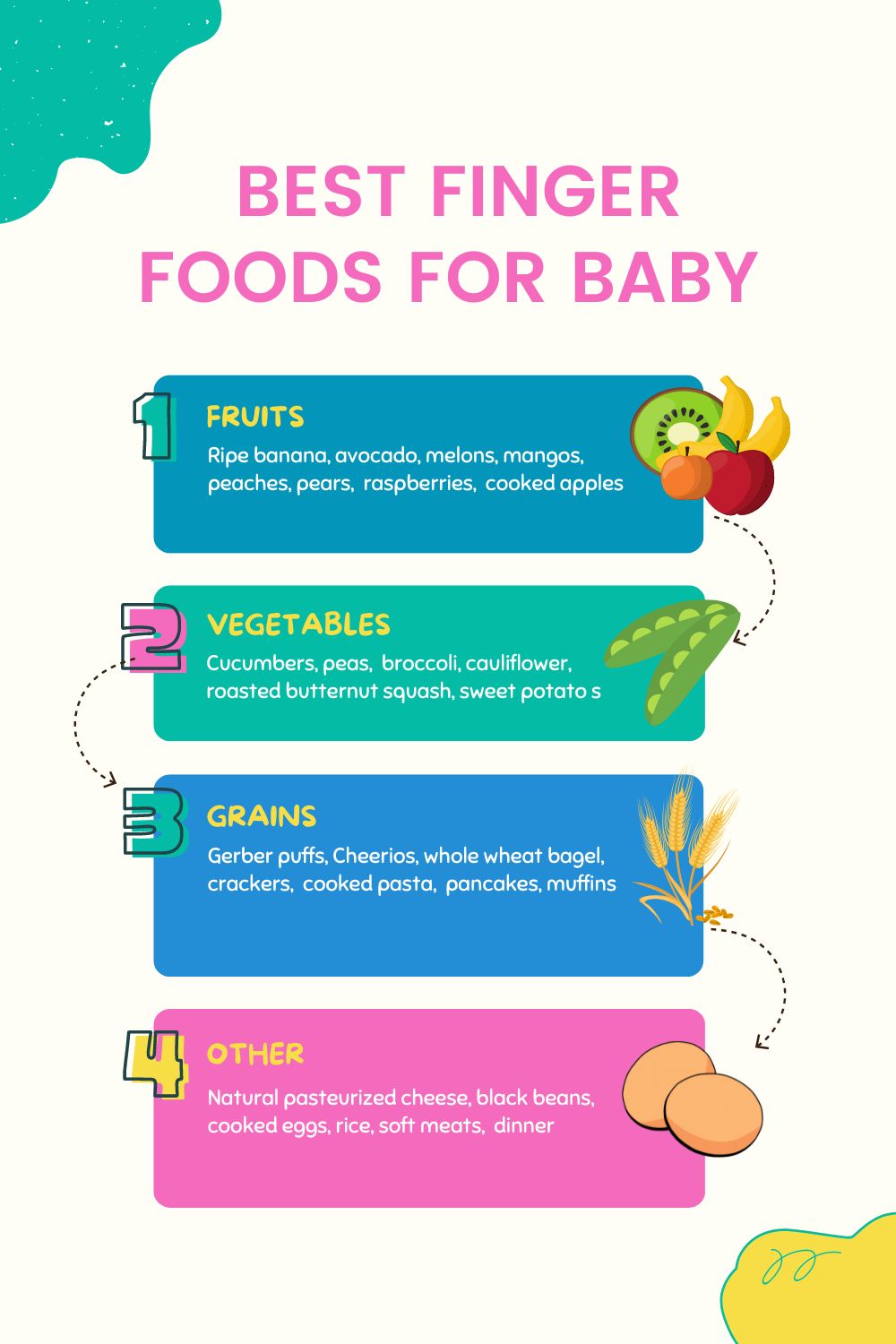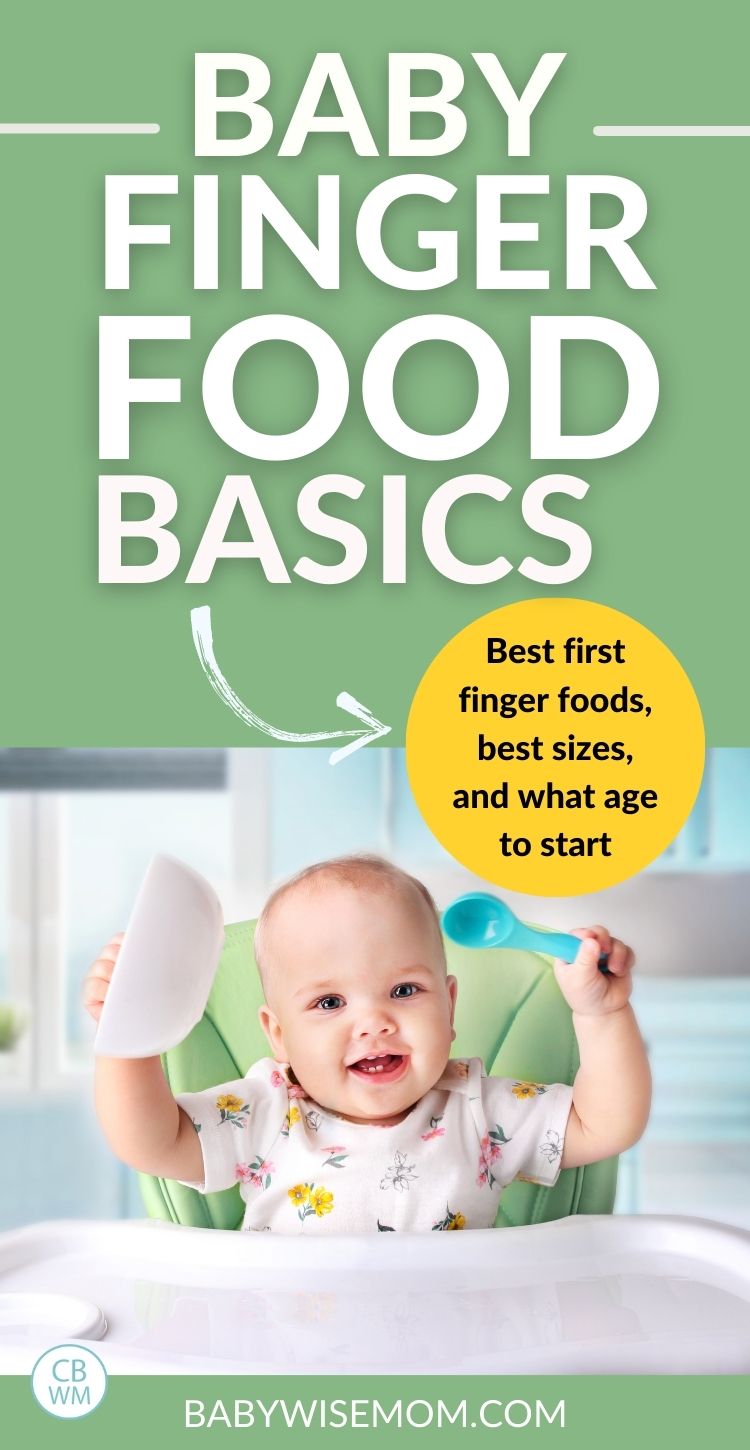Finger foods for babies. Signs baby is ready for finger foods. Good first finger foods. How to help baby learn to eat finger foods. What age is best to start introducing finger foods.

Finger foods! What a conundrum finger foods can be. I get a lot of questions surrounding finger foods.
I totally get it. You have a child you have been feeding nothing but milk for about 6 months or more and suddenly you are supposed to feed finger foods…but what is safe! At what age can I feed it! How small do I need to chop it! Do I cook it! What if my baby gags! Just a few questions that pop up.
I have to say that eating finger foods is one of my favorite milestones a baby reaches. The baby can eat food while you eat your meals. You can give finger foods when you go out to eat. You can offer little snacks at church to get the baby through the service…love it!
I was ridiculously cautious with Brayden eating foods and was the same with Kaitlyn. I don’t think there is anything wrong with caution–we don’t want our babies choking! But with my third and fourth babies, I relaxed a lot.
Post Contents
- WHAT AGE CAN YOU START FINGER FOODS?
- WHAT ARE SIGNS YOUR BABY IS READY?
- HOW DO I START?
- Best First Finger Foods
- SIZE/SHAPE/TEXTURE
- Best Shapes for Finger Foods
- CUTTING TIP
- WHAT DO I FEED BABY?
- Here is a list of other good foods to add to it as your baby gets older and more able:
- Teaching Baby to Eat Finger Foods
- GOOD BOOKS
- Conclusion
- RELATED POSTS
WHAT AGE CAN YOU START FINGER FOODS?
You can start when your baby is ready.
Don’t you just hate answers like that?!?!? That answer exists because there is no magical age when all babies are ready. Babies are individuals.
Generally speaking, some babies are ready as young as six months old. I have really done finger foods around the 7 month mark with all four of my children. See, mom needs to be ready, too.
Keep this in mind. There are thousands of mothers out there feeding their babies solids through Baby Led Weaning–which involves feeding a baby chunks of real food, not purees. These babies are not choking to death, so your baby can handle finger foods.
In a poll on this blog, I asked readers what age they started finger foods. Here is what they said:
Results:
6-7 months: 55 votes (33%)
7-8 months: 52 votes (31%)
8-9 months: 31 votes (19%)
9-10 months: 16 votes (10%)
10-11 months: 7 votes (4%)
11-12 months: 3 votes (2%)
12 months or older: 2 votes (1%)
Total of 166 votes
Years later, I asked that question again. So here is another poll asking people what age they started finger foods.
Results:
6 months old (83 votes) 83 (30%)
7 months old (52 votes) 52 (19%)
8 months old (72 votes) 70 (26%)
9 months old (41 votes) 41 (15%)
10 months old (14 votes) 14 (5%)
11 months old (4 votes) 4 (1%)
12 months or older (5 votes) 5 (1%)
Total of 271 votes
WHAT ARE SIGNS YOUR BABY IS READY?
Here are signs to look for that your baby can handle finger foods.
- Chew: You will want baby capable of making a “chewing” motion with her mouth when she has food in it.
- Desire: You will need baby to want to eat the food–you can’t force feed food–especially finger foods.
- Fine-Motor Development: Your baby will need to be able to pick up foods in order to eat finger foods.
- Age: Typically the age is 7-8 months old, but baby can be as young as 6 months old.
Your baby does not need molars or any other type of tooth. Teeth are not required. Your baby will not get molars until closer to a year or even older! (Brinley had no molars at 13 months old).
Keep in mind that your baby will need to practice to get good at eating these foods. So don’t be alarmed if the baby is not good at first. It will take time! She will get better as she practices it.

HOW DO I START?
Choose a food you feel comfortable with (see lists below). Cut it into the size/shape you feel comfortable with. Put a few pieces in front of your baby.
Next, I busy myself with something else to do–I stay close by, but I don’t stare down the child.
I tend to get involved more than I should, so if I see the poor dear struggling, I will pick the food up for her and put it in her mouth.
I think it is best for the child to learn to do it, and the best way to learn is to practice. That means I need to stay out of my baby’s way.
If you can sit and watch the struggle without saving your child, do it! But if you are like me, wash some dishes or look through a recipe book or something.
The first few times you do finger foods, there is a good chance your baby will gag. Don’t freak out. This is not for the faint of heart. Be there in case gagging leads to real choking (which in my four children it never has), but let the child work it up. This is unfortunately a real-life experience in learning how to chew and swallow food.
Best First Finger Foods
While gagging is normal, you still want to choose foods that do not pose a choking hazard.
With Brayden and Kaitlyn, I started with Gerber rice puffs. They dissolve really fast, and it takes 80 pieces to get 25 calories, so they aren’t a snack that is going to interfere with eating solid foods they need or prevent them from drinking enough breast milk.
I do that food until I can see they are able to chew and swallow. I am pretty slow in introducing new foods. I don’t have any set rule, I just do it as the thought occurs to me.
Kaitlyn really liked biter biscuits. They were great for her to learn to get the food in her mouth since they are big. Brayden never really loved those. Kaitlyn also liked toast. Both liked the Gerber Wagon Wheels.
Peas are an early finger food also.
Other foods I do are ideas I got from What to Expect the First Year. If you have that book, the info is found on pages 387-388.
Here is a list of good first finger foods for babies:
- Gerber puffs
- Peas (frozen peas can be quickly thawed by running under cold water)
- Pieces of whole wheat bagel
- Whole grain breads
- Crackers that get mushy in the mouth (not ones that soak up all moisture like saltines)
- Cheerios
- Natural cheeses (pasteurized)
- Ripe banana or other fruits that are very ripe
- Avocado
- Melons
- Cucumbers
- Peaches
- Pears
- Mango (just remember, if it is slippery, it can be difficult and therefore frustrating for your child)
- Cooked veggies (like roasted butternut squash)
- Cheerios
- Vegetables like sweet potato sticks
- Black beans

SIZE/SHAPE/TEXTURE
Size depends on you. You either want to go small pieces or big pieces–not in between.
It can be big enough the baby needs to take bites of it (so cut into long strips or wedges) or more into bite-sized pieces already.
Bite-sized pieces require a pincer grasp to pull off. Your baby will need that fine motor ability to be able to eat small pieces. Thing similar to a Cheerio.
I am a bit more cautious, so my pieces start out bite-sized, which is why my kids are a bit older than many with starting finger foods.
You can also start with whole foods–like a whole bagel. Your baby won’t put that whole thing in her mouth, but she will be able to hold the thing to her mouth. The younger the baby when starting, the larger the size will need to be.
The size you don’t want is the in-between where the child shoves it all in the mouth and has too much to chew.
Best Shapes for Finger Foods
The shape to avoid is the perfectly round circle–the one shaped like the esophagus. You know. You don’t want the baby putting the round beauty in her mouth, swallowing it whole, and lodging it in her throat.
I like to cut mine into little squares. If the baby is grabbing larger chunks, the Baby Led Weaning people say to do wedge-shaped food. This is easier for a baby to “fist.”
Be sure the foods you start out with aren’t too slippery. If you chop a banana up into squares, it will be too slippery for a baby to pick up. To do bananas, I cut about a 1-2 inch piece and then run my finger down the middle of it. It will break into 3 pieces. I then feed those pieces to the baby. You can help the texture by rolling the food in something safe for baby that is dry–like oatmeal (this tip is found in Super Baby Food by Ruth Yaron).
If you are feeding round foods like grapes or blueberries, cut them in half first so your baby will not choke on it.
As your baby gets older, she will be able to pick up even slippery foods.
CUTTING TIP
Make life easier! Use things to cut that will make it easier on yourself.
Use a pastry cutter, a pizza cutter, or kitchen scissors to quickly and easily chop things up. We use pizza cutters to cut up pancakes.
Sometimes your fingers are the fastest and easiest–for example I don’t cut olives with a knife, I just kind of smash them into several pieces. I squish it until it breaks and I rip it into four pieces. Much faster than cutting!
WHAT DO I FEED BABY?
You want to feed your baby a wide variety of foods to help prevent picky eating and to also get a varied diet in your baby.
In reality, if it is cooked correctly for a baby (in other words, soft enough), and cut into a good size for baby, you can feed baby just about anything you would normally eat. Nuts are a no as whole foods. Honey is a no….but baby couldn’t pick that up anyway.
You want to watch for food allergies, so feed baby foods she has had in pureed form OR wait a few days between each new type of food so you can watch for allergic reactions.
Here is a list of other good foods to add to it as your baby gets older and more able:
- Pasta–well cooked
- Cooked eggs–scrambled or boiled and crumbled
- Cottage cheese
- Rice
- Pancakes and other breakfast grains like that (waffles, muffins..)
- Grated carrots
- Soft meats like slow-cooked chicken
- Ground beef
- Olives
- Cooked apple
- Cooked zucchini sticks
- Fresh raspberries
- Steamed broccoli or cauliflower with the stem so baby can pick it up more easily
- Raisins
- Cherries that are pitted and cut in half or quarters
- Make old foods taste better–add some cream cheese to that bagel. Spread a thin layer of peanut butter on that bread.
- Whatever you are eating–whatever you are having for dinner, figure out how you can get it into baby-safe size for her to eat, too. Having tacos? Give her some taco meat, some tomatoes, some olives (chopped), some cheese, and some tortilla pieces. The taco would be messy, but she can feed herself the parts. Do the same for soup–separate it out of the broth and into food pieces baby can eat. The sooner you get your baby eating what your family regularly eats the better chance you have for having a toddler and older who just eats dinner rather than complaining about dinner.
Note that steaming or roasting your vegetables will keep the most nutrients in them. You don’t want to cook all of the vitamins out of your veggies.
Teaching Baby to Eat Finger Foods
The best option is to give them the food and let them figure it out. I would give them food that is safe, but also big enough they can pick it up and get it in their mouths.
Help them be successful. For a 7 month old, the Gerber Rice Puffs are likely too small to get in their mouths by themselves. You can feed rice puffs yourself to gauge the chewing ability.
Brayden had no problems feeding himself finger foods at 7 months old, even the small rice puffs. Kaitlyn could pick the rice puffs up, but wouldn’t put them in her mouth. She needed a bigger item to show her that she could do it herself, then she immediately was able to get the rice puffs in her mouth alone.
GOOD BOOKS
I love, love LOVE Super Baby Food by Ruth Yaron.
Another resource you might like (that I haven’t read) is Baby Led Weaning by Gill Rapley and Tracey Murkett.
Conclusion
You do not want to be spoon-feeding your baby forever. Work to start simple finger foods so your baby can learn to feed herself.
RELATED POSTS

This post originally appeared on this blog in September 2013

With my 6 month old I've been doing a combo of purees and Baby Led Weaning. Mostly because I had already started oatmeal before I found out of BLW, but she does great with both!I still do the oatmeal mixed with peaches because she LOVES that! So I teach table manners (no helping, keeping hands on tray) with the oatmeal, and then I put all the food we're eating on her tray and let her go at it. She loves it and never tries to put it anywhere besides her mouth.I do still test for some allergies but according to our Pediatrician, unless the allergy runs in the family, there is a super slim chance of it suddenly occurring in my LO. But at 6.3 months, she's eaten everything we have (minus anything with sugar)–roasted veggies with spices, meatloaf, beans, all kinds of fruit, etc.It's so fun!
This is soooooo helpful! My little guy just turned 8 months old and he was reaaaally struggling when I put little pieces of food in front of him. He would freak out and not understand that he could pick them up and eat them. Turns out the pieces were too small for him. I gave him strawberries cut in half and bam! He picked it right up and ate it! So fun. And so glad that hurdle is over with. #newmomproblems Thank you so much babywise momma 🥰
You are welcome!